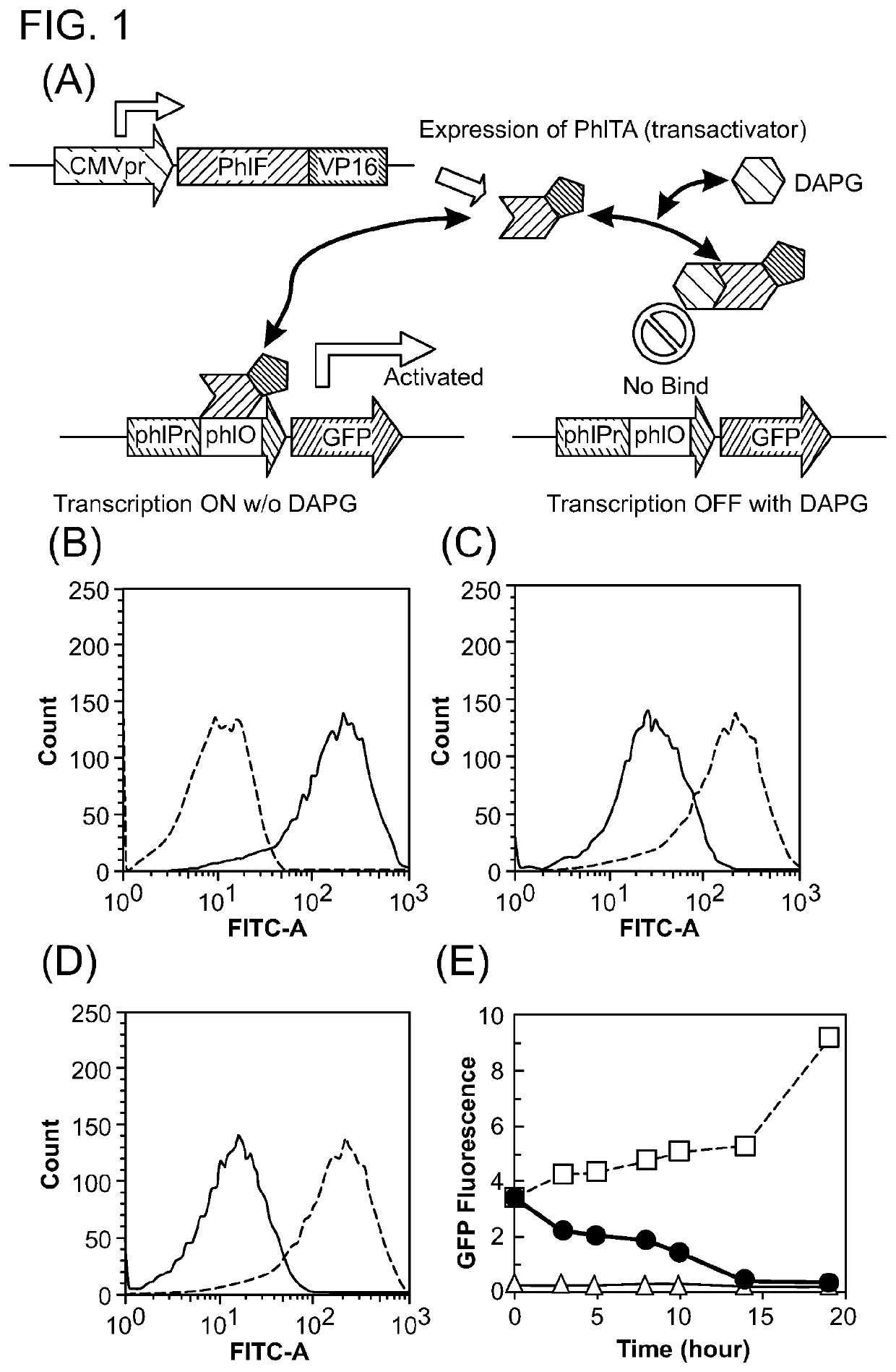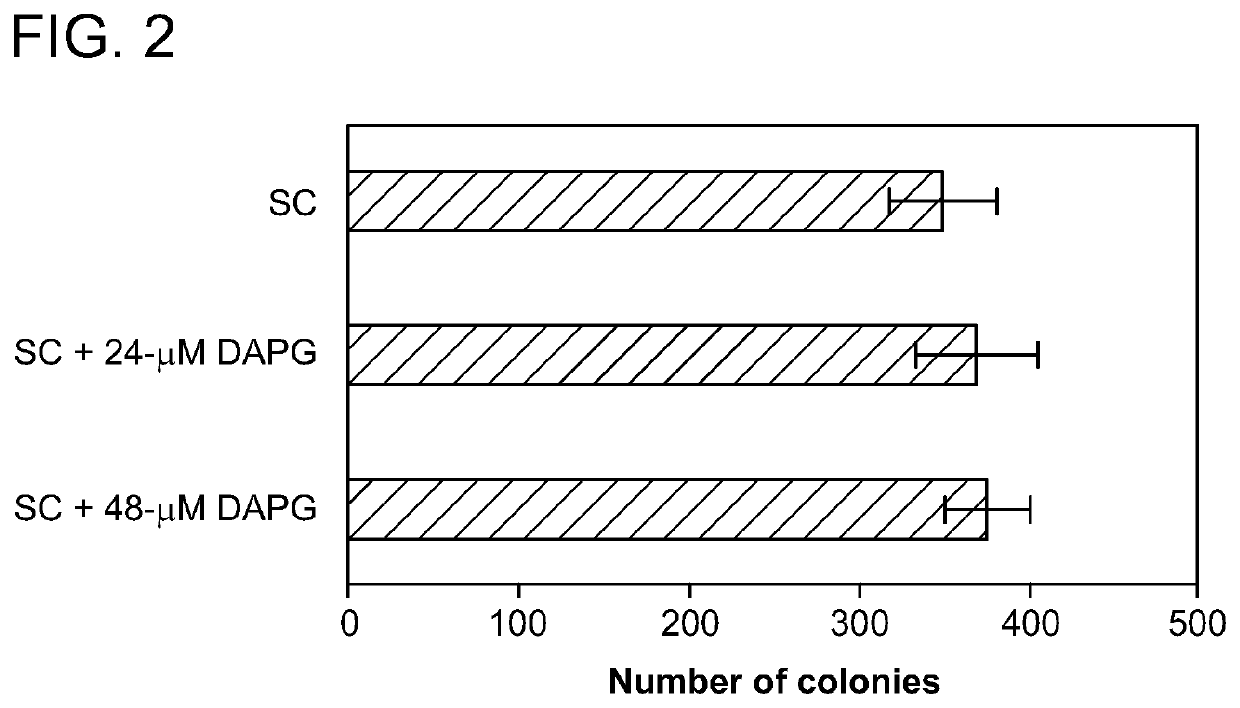Orthogonal transcriptional switches derived from tet repressor homologs for saccharomyces cerevisiae
a transcriptional switch and saccharomyces cerevisiae technology, applied in the field of yeast genetics, to achieve the effect of detecting activity
- Summary
- Abstract
- Description
- Claims
- Application Information
AI Technical Summary
Benefits of technology
Problems solved by technology
Method used
Image
Examples
example 1
and Methods
[0083]The following materials and methods were utilized in the examples described herein.
Media
[0084]Yeast strains were cultured in YPD or SD-based medium supplemented with needed nutrients. SC is a fully supplemented medium of SD, and SC lacking three components, such as leucine, histidine, and adenine, is referred to as SC-Leu-His-Ade. The following drugs added to yeast media were purchased from Santa Cruz Biotechnology (Dallas, Tex.); 2,4-diacetylphloroglucinol (DAPG), coumesterol, and gentamicin. The drugs virginiamycin 51, quercetin, 2-benzyl acetate, D-camphor, and G418, were bought from Sigma-Aldrich (St. Louis, Mo.). Doxycycline, p-cumate (p-isopropylbenzoate), and fisetin were purchased from Clontech laboratories (Mountain View, Calif.), System Biosciences (Mountain View, Calif.), and Fisher Scientific (Pittsburgh, Pa.), respectively.
[0085]Escherichia coli cells were grown in Luria Broth (LB) medium. Carbenicillin (Sigma-Aldrich), kanamycin (Sigma-Aldrich), chlora...
example 2
ion of a PhlF-Based Transcriptional Regulator and a phlF Operator-Embedded Promoter for the DAPG-Off System
[0094]One of the TetR homologs, a PhlF-based transcriptional activator, named phlTA, was constructed by fusing Pseudomonas PhlF (GenBank AAF20928.1) to three tandem repeats of a VP16 transcriptional activation domain derived from herpes simplex virus Type 1 (Baron et al., 1997 Nucleic Acids Res., 25: 2723-2729). Here, the CMVpr from human cytomegalovirus was used to drive the appropriate level of phlTA expression.
[0095]The promoter used for phlF-dependent expression of a reporter gene was built by embedding seven repeats of the phlF operator sequence (phlO) between the alcohol dehydrogenase ADH1 terminator and a CYC1 (cytochrome c) promoter from which the endogenous UAS (upstream activating sequence) had been removed. The resulting promoter was named phlPr, the architecture of which was analogous to a promoter used in yeast Tet- and Camphor-Off systems (Gari et al., 1997 Yeast,...
example 3
ce of the DAPG-Off Switch with a GFP Reporter
[0097]The performance of the DAPG-Off system was examined using GFP as a reporter. A yeast transformant, DapG-TA (SIY1001), which had phlTA and the phlPr-gfp reporter, was constructed by integrating plasmid pSIB918 in BY4741 (Table 1 and Table 2). The DapG-TA strain showed significant expression of GFP in the absence of DAPG, unlike control strain BY4741 (FIG. 1B). In addition, the GFP fluorescence of the DapG-TA was higher than that of the BY4741 control strain (background) in the presence of 12-μM DAPG, but decreased to the same level as BY4741 at 48-μM DAPG (FIG. 1B-FIG. 1D). These data indicated that the expression of the reporter GFP was regulated in a DAPG-dependent manner, consistent with predictions. Furthermore, the DapG-TA strain was then used to evaluate the kinetics of the DAPG-Off switch. The intensity of GFP showed an increase over a 19-h period in the absence of DAPG, whereas the fluorescence reduced to background levels ov...
PUM
| Property | Measurement | Unit |
|---|---|---|
| Composition | aaaaa | aaaaa |
| Gene expression profile | aaaaa | aaaaa |
Abstract
Description
Claims
Application Information
 Login to View More
Login to View More - R&D
- Intellectual Property
- Life Sciences
- Materials
- Tech Scout
- Unparalleled Data Quality
- Higher Quality Content
- 60% Fewer Hallucinations
Browse by: Latest US Patents, China's latest patents, Technical Efficacy Thesaurus, Application Domain, Technology Topic, Popular Technical Reports.
© 2025 PatSnap. All rights reserved.Legal|Privacy policy|Modern Slavery Act Transparency Statement|Sitemap|About US| Contact US: help@patsnap.com



